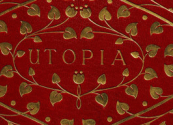Comments on Stillman and Mahlberg’s Discussions of The Isle of Pines
by Kate Eickmeyer
What a very strange little text The Isle of Pines is. Three issues leap out from Neville’s deceptively casual narrative style: (i) George Pines’ enthusiastic polygamy, (ii) the severity of punishment and total absence of due process under Henry Pines’ law, and (iii) the racial dimensions of both circumstances. At first I read The Isle of Pines as misogynistic fantasy metamorphosed into racist cautionary tale about overpopulation and idleness, but the historical context explained in Gaby Mahlberg and Peter Stillman’s articles in the assigned issue of Utopian Studies brought my attention to the parody at work and Neville’s more likely agendas. Stillman identifies George Pines’ resemblance to Charles II and his brother James II, both of whom indulged in an array of mistresses and prioritized their polyamorous personal lives and over statecraft and England’s well being (157). Stillman posits Neville’s allegory as a direct warning: “George’s misrule, or failure to rule, leads the Isle of Pines to internal breakdown. Will not, The Isle of Pines suggests, the rule of Charles II do the same to the island of England?” In that light, Neville’s pamphlet reads as a clear reference to the dangers of absolute monarchy and the need for structured government and rule of law.
Establishing the degree of Neville’s political radicalism vis-à-vis monarchy is perhaps essential to understanding how far his parody goes. If, as Stillman suggests, the pamphlet is a “brief but powerful statement against unlimited monarchical power and patriarchal political thought,” to what extent are each of the three issues so startling to present sensibilities called into question (9)? In other words, if George and Henry are flawed monarchs, and the Isle is their flawed kingdom, does it follow that the sexism, racism and draconian system of punishment that are the direct products of George and Henry’s leadership also fall within Neville’s critique?
On the one hand, it seems highly anachronistic to attribute such views to Neville, and the nuances of Neville’s position on monarchy might suggest alternatives. Stillman refers to the “tumble of arguments” over absolute monarchy, constitutional monarchy and republicanism that unfolded during Neville’s lifetime, and indeed it seems impossible that Neville’s republicanism is so straightforward in an era of such complex (and mercurial) political conflict (157). Gaby Mahlberg’s article, “Historical and Political Contexts of The Isle of Pines,” seems to be omitted from the dropbox PDF, but it has a lot to say about this issue so I wanted to mention it in case others missed it too (it’s available in full text via the library website). Mahlberg evidently has published quite a lot about The Isle of Pines and Neville in general, and she points out that Neville’s politics were less radical than “Neo-Harringtonian” desires for a republic without a monarch (112). She never quite pins down the nuances of Neville’s politics, but much like The Isle of Pines, maybe they defy such clear classification. Regardless, if Neville’s views of monarchy were mixed, then we have grounds for excluding monarchy’s allegorical products from his critique.
Yet, Mahlberg’s account of Neville’s political career does portray him as a clear Republican and even a Neo-Harringtonian. Mahlberg notes that Neville fought unsuccessfully for “a new type of government by a ‘single person,’ a ‘senate,’ and a ‘popular assembly’” (121). That sounds familiar, and suggests that Neville’s Republicanism was ahead of its time. After all, the British political debates of this era paved some of the intellectual roads for the founding of the U.S. government 100 years later, and the English Bill of Rights, which forbade cruel and unusual—although not capital—punishment, was passed in 1689, 21 years after the publication of The Isle of Pines and at the end of the Exclusion Crisis. Additionally, the Magna Carta and its due process requirements had been revived recently under Charles I’s reign, and its contents were the subject of ongoing debate. Mahlberg describes Neville’s opposition to Oliver Cromwell (who, according to Lord Woolf, Lord Chief Justice of England and Wales in 2005, dismissed the Magna Carta as the “Magna Farta”—thanks, Wikipedia). The unfortunate consequences of George and Henry’s reign also could be construed as an argument in support of due process and the Magna Carta’s revival and against Cromwell specifically.
Even so, neither the Magna Carta nor the 1689 Bill of Rights were concerned with the connection of race with due process and excessive punishment. It’s notable that both executions that take place in the text are not only of black men, but are also of men accused of sexual crimes. Clause 54 of the Magna Carta stated that no man could be imprisoned on the testimony of a woman, except in the event of her husband’s death. Maybe Neville was less concerned about the targeting of black men as the targeting of men based on the testimonies of women; the Isle’s disorder is inevitable in the absence of laws like Clause 54. Along the same lines, perhaps George’s polygamy functions entirely as an allegory for political patriarchy and distraction from statecraft, and the misogynistic aspects are clear only to our present readings.
I also wanted to mention Stillman’s discussion of the Isle as an arcadia and its Hobbesian engagement of the state of nature, which opens up another line of inquiry. And, as an aside, I’ve always found Restoration politics, with all its crises and parliaments, rather murky, and if anyone with more expertise can recommend a good general history of it, I’d be interested.
Here’s a link to Lord Woolf’s charming discussion of the Magna Carta, in case anyone is curious: http://webarchive.nationalarchives.gov.uk/+/http://www.dca.gov.uk/judicial/speeches/lcj150605.htm#4


